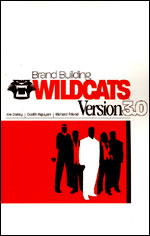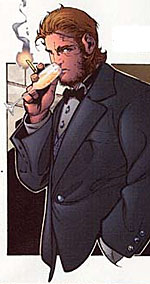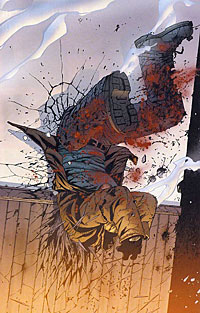>> The Book Review: The Horde
>> What About Bob? An interview with Bob Schreck, Part Two
More...

 Writer: Joe Casey
Writer: Joe Casey
Artist: Dustin Nguyen
Colourists: Randy Mayor, Larry Molinar
Letterer: Comicraft
Inker: Richard Friend
Collecting WILDCATS VERSION 3.0 #1-6
Price: $9.95
Publisher: DC WildStorm
ISBN: 1401201199
Corporations are everywhere. We're afraid of them, and of the power they wield and the ways they use it. And while most of the people who run corporations don't wake up thinking, "What can I do to kill people and destroy the world today?" (alright, maybe at Exxon Mobil), nor do they wake up and wonder how they can improve the world.
In WILDCATS 3.0: BRAND BUILDING, the CEO does just that. And what better medium to examine corporations and consumer culture than comics, where often the corporate logo or brand name is more important than the quality or the book or the talent behind it?
BRAND BUILDING is an odd book for many reasons, but it's also a great book. Having never read anything by Joe Casey before, nor having read the previous two WILDCATS series, I had reservations about picking up this book despite having heard good things. All I knew about it was that they were a superhero team, but I wouldn't be able to recognise any of the characters or explain how they're different from any of the thousands of other X-Men rip-offs.
In the book, Jack Marlowe runs the Halo Corporation. Now, Marlowe may be a superhuman or a robot or an alien, I'm not quite sure, but he teleports all over the world and is the epitome of wireless communications. The brief introduction describes him as an "alien, biosynthetic humanoid warrior" and the truth is, I'm far too old to spend time breaking that phrase down. I'm content to simply accept his power and let the story run its course.
 Marlowe goes on a shopping spree, buying up ad agencies, accounting firms and media companies as Halo introduces a new line of batteries that last forever. Yes, forever - and by the end of the book, Casey shows signs that he's really thought about the implications that a perpetual power source could have on the world, which suggests that the book has much more to offer in the future.
Marlowe goes on a shopping spree, buying up ad agencies, accounting firms and media companies as Halo introduces a new line of batteries that last forever. Yes, forever - and by the end of the book, Casey shows signs that he's really thought about the implications that a perpetual power source could have on the world, which suggests that the book has much more to offer in the future.
Meanwhile there's a more typical action subplot as Agent Wax of the National Parks Service (they do more than count trees, just in case there was any doubt), who secretly works for Marlowe, teams up with another Marlowe employee, Cole Cash, to track down a federal agent who's gone missing. During their search, they team up with CC Rendozzo, an information power broker with a colourful crew of underworld operatives, and an agenda of her own.
The storyline starts out interesting, involving the chemical and bionic manipulation of agents by the government and the possible clash of government interests, underworld power and Marlowe's attempts to develop and consolidate power in different spheres. But then it takes a turn towards the absurd, and dwells there a little too long. It's as if Casey decided to cater to the audience of fanboys that make up most of the comic-buying population and split the book between his interesting ideas and the action scenes so many people expect from a comic.
However, the most interesting character in the book is Edwin Dolby, an accountant whose firm is bought by Marlowe, and who, in the process, becomes one of Marlowe's most valued business advisors. Part of what makes Dolby so interesting is that he truly believes Marlowe will change the world and is doing it for the better. The question remains, what will happen to his idealism and what role he will play in the company.
 Joe Casey is assisted by Dustin Nguyen, a penciler I'm not familiar with, who collaborates on the covers with designer Rian Hughes. Nguyen has a great sense of anatomy and pacing, and he handles the action scenes with style and does a solid job of pulling off the lengthy conversations the script throws up. The art style isn't as experimental as the writing, which seems intentional. This is a comic that looks like a superhero book, but is really something different when the spine is cracked open and read.
Joe Casey is assisted by Dustin Nguyen, a penciler I'm not familiar with, who collaborates on the covers with designer Rian Hughes. Nguyen has a great sense of anatomy and pacing, and he handles the action scenes with style and does a solid job of pulling off the lengthy conversations the script throws up. The art style isn't as experimental as the writing, which seems intentional. This is a comic that looks like a superhero book, but is really something different when the spine is cracked open and read.
I'm focusing on the flaws of the book rather than its strengths, but that's because the book falls frustratingly short of brilliance. Casey does a great job of writing both the superhero characters and the ordinary people, and by attempting to take superhero characters and use them in a realistic fashion in a realistic world, the book shows real potential. It's a story that's based not in adolescent power fantasies, but in realistic conflicts of power and influence.
Marlowe runs the Halo Corporation in a way that suggests he still regards himself as a superhero. Meanwhile, the gunfighters and information brokers work in the shadows, manipulating and being manipulated, but never operating in the same spheres as Marlowe. It's a much more nuanced version of reality than most comics play with, and it treats its readers with a little more intelligence. It's hard to nitpick a comic where two characters spend four pages discussing the implications of the 1886 Supreme Court decision, Santa Clara County v Southern Pacific Railroad.
BRAND BUILDING is a strong work, restricted by the demands of the 22-page chapter format and the obligations of action sequences - factors that distract from the characters and the innately complex situations drive the book.
However, it's also an excellent example of just how dynamic the medium is. It's an exciting, genre bending story, and maybe it ain't perfect, but there aren't many comics out there even trying to be this good. If Casey can strike the right balance in future stories, this could be the opening chapter of a brilliant and groundbreaking series that will have people talking for years to come. So it's worth getting in on the ground floor.

This article is Ideological Freeware. The author grants permission for its reproduction and redistribution by private individuals on condition that the author and source of the article are clearly shown, no charge is made, and the whole article is reproduced intact, including this notice.


